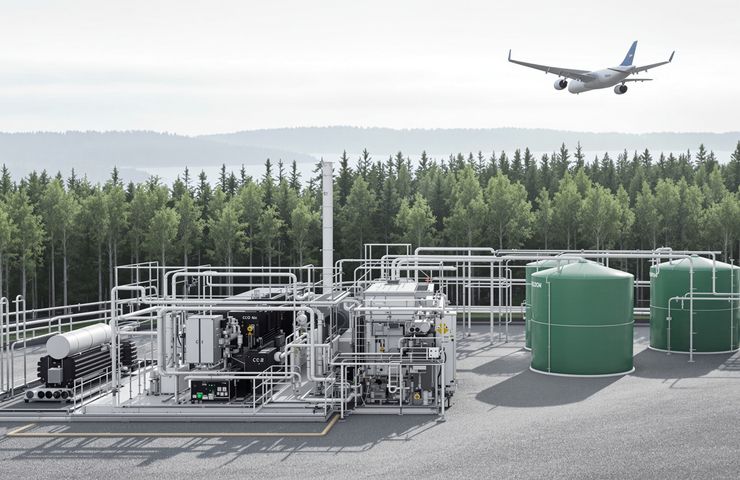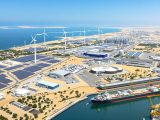
Hydrogen Production Through Electrolysis Fuels Finland’s First eSAF Pilot
August 21, 2025At long last, Finland’s aviation industry is set to take off into greener skies. In autumn 2025, a pre-commercial electro Sustainable Aviation Fuel (eSAF) pilot in Espoo will launch, harnessing low-temperature electrolysis to turn biogenic CO2 and green hydrogen into jet fuel. And this is no mere demo—it’s Finland’s first pre-commercial facility aimed squarely at bridging the gap between bench-scale experiments and a full industrial rollout. With the EU’s 2030 SAF blending rules looming, the hope is to slash hundreds of millions of tonnes off aviation’s carbon footprint and show that synthetic fuels can truly scale.
What’s Happening
Liquid Sun, a Tampere University spin-off, has sprinted to the front of the pack in electrolysis tech for green fuels. They’ve pulled in nearly €4 million in seed and VC rounds, working with Soletair Power on Direct Air Capture and teaming up with Austria’s GIG Karasek for process engineering savvy. Now they’re joining forces with national carrier Finnair, electrification titan ABB, energy heavyweight Fortum, and airport operator Finavia to build Finland’s first pre-commercial eSAF pilot plant in Espoo’s industrial park. The cherry on top? That synthetic jet fuel will flow straight into the Helsinki-Vantaa supply chain.
Why This Matters
Cutting emissions in aviation is no walk in the park: biofuels hit feedstock walls, and fully electric or green hydrogen planes aren’t ready for long-haul routes yet. Enter eSAF. By using renewable electricity, captured CO2, and green hydrogen, it truly closes the carbon loop—potentially slashing life-cycle greenhouse gases by up to 90% versus fossil jet fuel. It’s tailor-made for the EU’s ReFuelEU Aviation rule, which requires at least 6% of jet fuel to be sustainable by 2030. It’s also a prime example of industrial decarbonization in action, with Finland vying to lead the charge in the global e-fuel market—if they can scale up and hit the right price point.
How It Works
At the heart of this pilot is low-temperature electrolysis (LTE), which uses moderate heat—think under 100 °C—to split water and CO2 into a ready-made syngas cocktail. Here’s the gist:
- Renewable juice from Fortum wind and solar parks powers a custom Liquid Sun electrolyser, making hydrogen production a reality.
- The electrolyser feeds on water (H2O) and biogenic CO2—sourced from nearby forest and biogas plants—to churn out CO and H2.
- That syngas mix gets cleaned up and sent into a Fischer–Tropsch reactor, stitching together long-chain hydrocarbons perfect for jet engines.
- The final result? A drop-in eSAF blend that slots straight into existing fuel systems at Finavia-run airports, no engine mods needed.
From Lab to Pilot
There’s no shortage of demo-scale electrolysers across Europe and North America, but few have edged close to commercialization. Liquid Sun burst out of Tampere University in 2023 on the back of new electrode materials and cell designs that boost both energy efficiency and durability—critical for upscaling. Partnerships with Soletair Power added Direct Air Capture modules for flexible CO2 sourcing—either forest-industry emissions or ambient air. Meanwhile, GIG Karasek provided the scale-up know-how, translating bench-scale reactor kinetics into a pilot-ready process skid. After fine-tuning in Tampere, they picked Espoo for its industrial network and proximity to aviation infrastructure. It’s all part of a bigger push toward industrial decarbonization.
Finland’s Edge
Espoo, Finland’s second-largest city, has transformed from pastoral farmland into a cleantech powerhouse over the last four decades. Home to Aalto University and an array of R&D hubs, the city offers deep talent pools, pilot-scale fabrication facilities, and steady sustainable energy from district heating and on-grid renewables. Plus, Finland’s forest industry churns out millions of tonnes of biogenic CO2 each year—a feedstock hardly anyone else taps for fuel synthesis. By basing the eSAF pilot here, partners cut transport and energy loss, sketching a blueprint for circular carbon management in aviation.
Broader Impact
Beyond the obvious emissions cuts, this pilot could spark a slew of positive knock-on effects:
- Domestic value chain: From CO2 capture to fuel distribution, Finland could build an end-to-end ecosystem spanning R&D, manufacturing, and logistics.
- Jobs & skills: Expect new roles in electrolysis engineering, catalyst development, and modular plant ops—boosting local economies.
- Technology export: If Espoo’s model flies, Finnish electrolysis units and process know-how could find eager markets in global decarbonization efforts.
- Policy momentum: Demonstrating a real-world eSAF supply may accelerate carbon pricing, investment grants, and SAF blending incentives.
Funding & Partnerships
Securing nearly €4 million in early-stage backing—from Voima Ventures and others—underscores investor confidence in green hydrogen and synthetic fuel tech. The multi-industry consortium—airline, energy supplier, airport operator, industrial tech firm, and cleantech start-ups—reflects the complexity of industrial decarbonization. Each partner brings a unique piece: Finnair provides fuel off-take and regulatory insight; ABB integrates automation and grid interfaces; Fortum supplies renewable power; Finavia manages storage and blending at airports; while Liquid Sun, Soletair Power, and GIG Karasek deliver the core process technologies.
Challenges Ahead
Of course, there are hurdles. Electrolysis is energy-hungry—operational costs ride on electricity pricing and how often you can crank up the plant. Scaling from kilowatt demos to multi-megawatt installations will demand tougher materials and more durable stacks. Sustainable CO2 sourcing must ramp up without triggering land-use conflicts or bottlenecks. And the global SAF market is still taking shape, so high production costs may need policy support—think carbon credits or minimum blending quotas—to level the playing field.
Looking Ahead
As autumn 2025 approaches, all eyes in the sustainable energy community will be on Espoo’s pilot skid. If this pre-commercial unit nails its targets—solid uptime, competitive costs, and top-tier fuel specs—full-scale plants could be in the cards by 2028. That timeline dovetails nicely with airlines’ 2050 net-zero commitments and could tip the balance toward zero-emission long-haul travel. For anyone tracking hydrogen production, carbon recycling, and cyclic electrification, it’s thrilling to see theory turn into runway-ready reality. The future of flight might just take off from Espoo.



 With over 15 years of reporting hydrogen news, we are your premier source for the latest updates and insights in hydrogen and renewable energy.
With over 15 years of reporting hydrogen news, we are your premier source for the latest updates and insights in hydrogen and renewable energy.